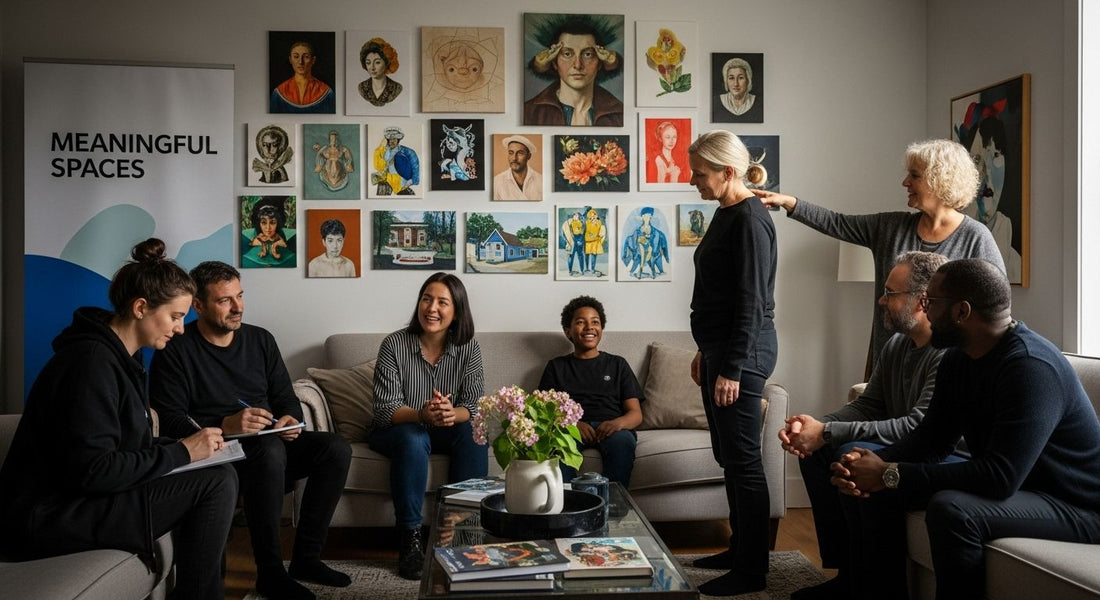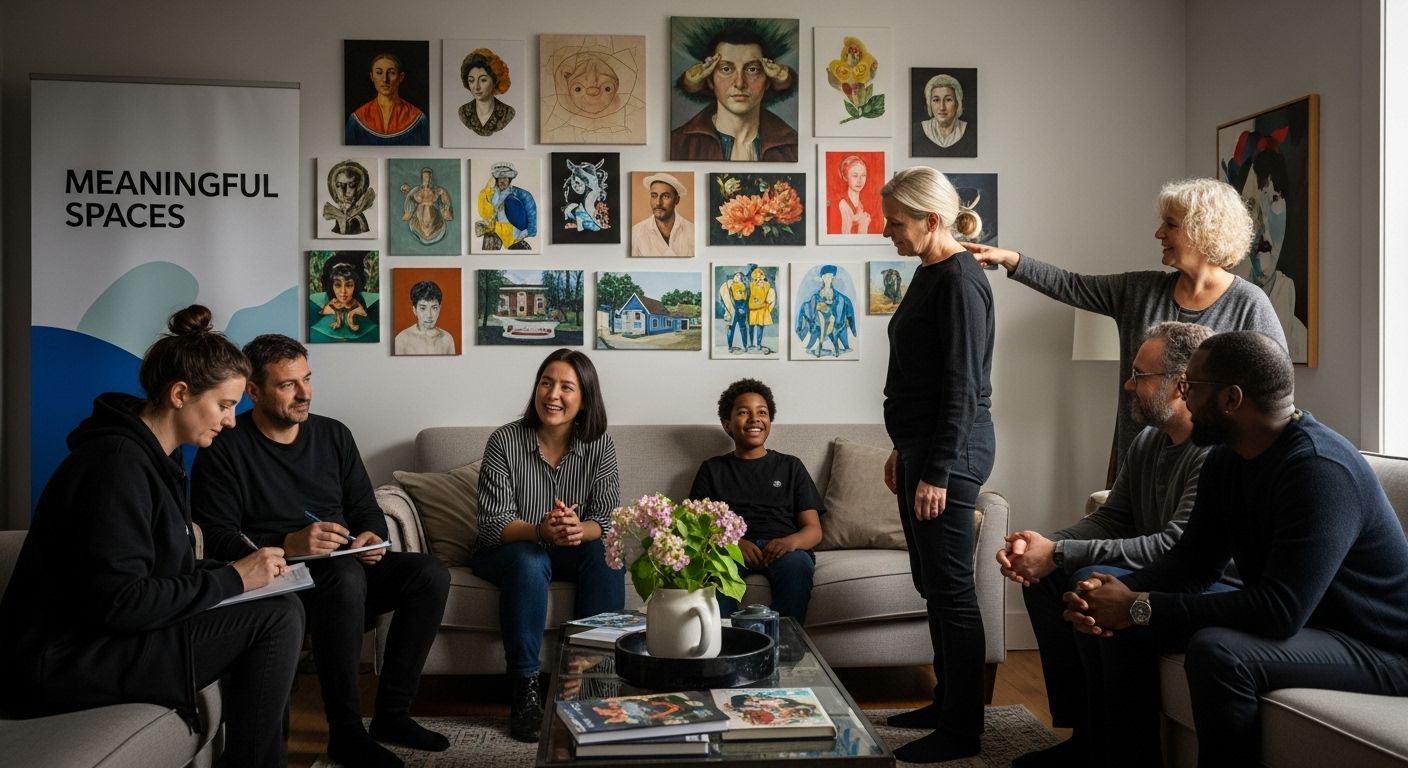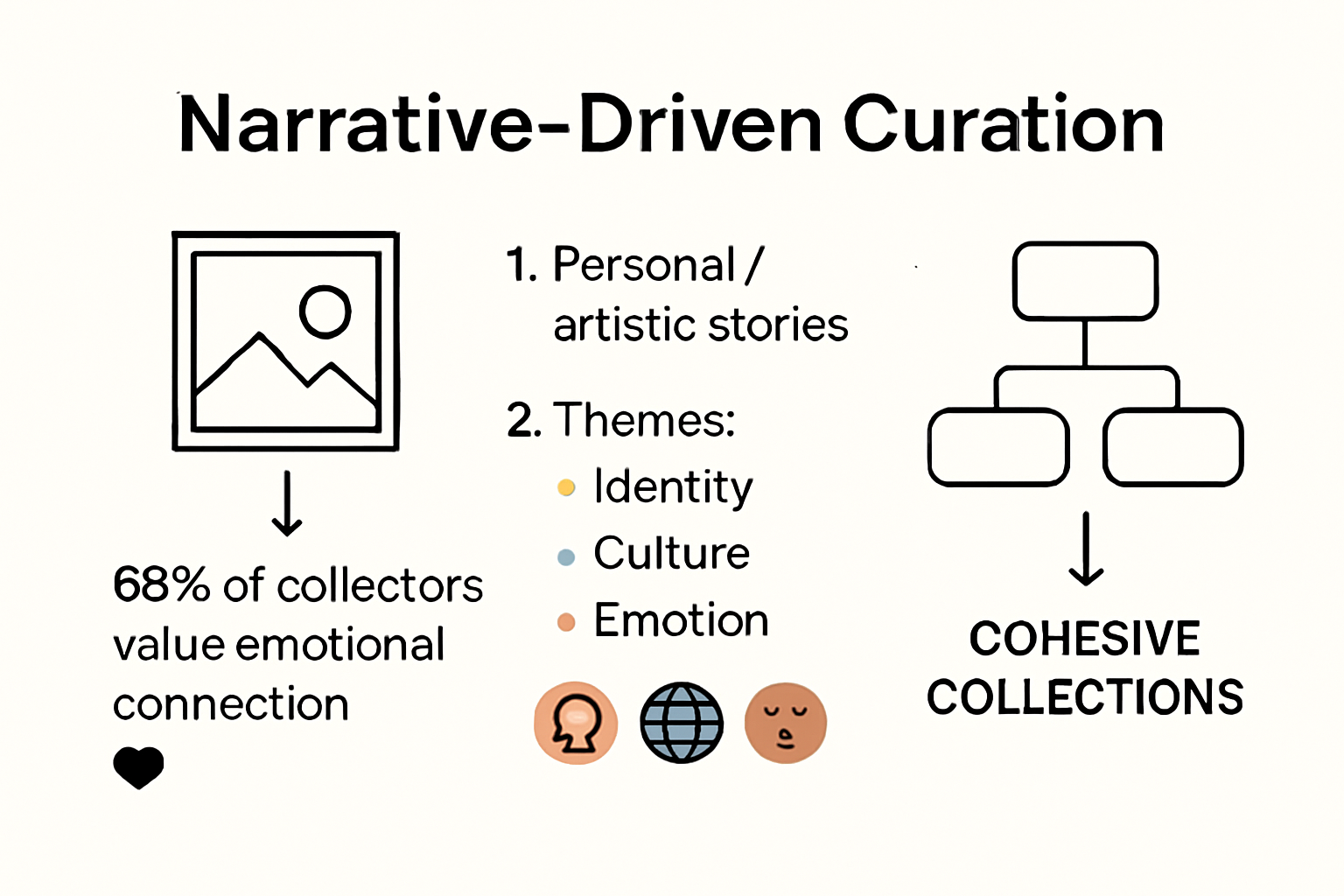
Narrative in Art Collections: Creating Meaningful Spaces

Art collections do more than decorate a room. They can actually shape how we feel and think by weaving powerful stories into our everyday spaces. Most people only notice the colors or the frames and miss that over 68 percent of art collectors say emotional connection to the story is why they buy. Here’s what changes everything. When you curate with narrative, your walls invite conversations, spark memories, and make your home come alive with meaning.
Table of Contents
- The Importance Of Narrative In Art Collections
- Choosing Art That Tells A Story
- Enhancing Spaces With Story-Driven Wall Art
- Supporting Artists Through Narrative-Focused Collection
Quick Summary
| Takeaway | Explanation |
|---|---|
| Narrative enriches art collections | Art pieces convey deeper stories, connecting viewers emotionally and intellectually with diverse human experiences. |
| Choose art that resonates personally | Select artworks that evoke emotional responses or relate to your personal journey, enhancing your space’s storytelling potential. |
| Curate cohesive narratives with artwork | Arrange art to create thematic connections, turning simple displays into immersive storytelling environments that invite exploration. |
| Support artists through narrative-focused collections | Collecting art with meaningful stories helps sustain artists and promotes diverse cultural expressions and critical conversations. |
| Utilize visual storytelling techniques | Employ color, composition, and symbolism to create dynamic spaces that communicate complex narratives beyond mere aesthetics. |
The Importance of Narrative in Art Collections
Art collections are more than just assemblages of visual objects. They represent complex storytelling mechanisms that transform spaces, connect viewers with deeper emotional experiences, and communicate profound human narratives. Narrative in art collections goes beyond mere decoration, serving as a powerful medium for expressing cultural, personal, and social perspectives.
Storytelling Through Visual Language
Art has always been a fundamental method of human communication. The National Museum of Women in the Arts emphasizes that narrative art conveys information visually, using symbols and intricate details to tell stories that transcend time and place. Each artwork becomes a chapter in a larger narrative, inviting viewers to explore complex emotional landscapes and understand diverse human experiences.
Visual storytelling allows artists to communicate ideas that might be challenging to express through words alone. Through carefully selected compositions, color palettes, and symbolic elements, artists create immersive narratives that engage viewers on multiple sensory and intellectual levels. These narratives can challenge perceptions, provoke thought, and inspire emotional connections.
Cultural and Social Significance
Crystal Bridges Museum of American Art highlights that art serves as a visual language communicating ideas and stories that can fundamentally alter perspectives and inspire action. Narrative art collections become powerful tools for social commentary, allowing viewers to explore complex societal themes through visual representation.
Through strategic curation, art collections can tell stories about historical moments, cultural identities, personal journeys, and collective experiences.
The following table compares different types of narrative explored in art collections, summarizing their focus and examples provided in the article.
| Narrative Type | Focus | Example or Context |
|---|---|---|
| Cultural | Cultural identities, heritage | Historical moments, collective memory |
| Social | Societal issues, transformation | Social commentary, action, marginalized voices |
| Personal | Individual experiences or journeys | Portraits, personal growth, self-discovery |
| Emotional | Evoking emotions and connections | Artworks that provoke reflection or conversation |
Each piece becomes a witness to human emotion, struggle, triumph, and transformation. By presenting these narratives, art collections create spaces that are not just visually appealing but intellectually and emotionally engaging.
Creating Meaningful Connections
The power of narrative in art collections lies in their ability to create meaningful connections between the artwork, the artist, and the viewer. The Getty Museum’s ‘Stories in Art’ curriculum explores how artists use character, setting, and plot to tell stories visually, demonstrating that effective narrative art transcends simple representation.
When curating a collection, collectors and designers can intentionally arrange artworks to create dialogue, reveal interconnected themes, and invite viewers into a deeper understanding of the human experience. This approach transforms art collections from static displays into dynamic, living narratives that continue to evolve and speak to viewers across different contexts and time periods.
Ultimately, narrative in art collections is about creating spaces that tell stories, provoke thought, and connect people through shared visual experiences. It is a testament to art’s enduring power to communicate, inspire, and transform our understanding of ourselves and the world around us.
Choosing Art That Tells a Story
Selecting art that genuinely communicates a narrative requires more than aesthetic appreciation. It demands a thoughtful approach that considers emotional resonance, personal connection, and the deeper stories embedded within each artwork. Narrative art transforms spaces from mere visual displays into powerful storytelling environments that invite viewers into complex emotional and intellectual experiences.
Understanding Personal and Artistic Narratives
When choosing art that tells a story, collectors must look beyond surface-level visual appeal. The Metropolitan Museum of Art suggests that meaningful artwork contains layers of symbolism, cultural context, and personal expression that reveal themselves through careful observation.
Artworks carry inherent narratives through multiple elements: composition, color palette, subject matter, and the artist’s personal background. A portrait might reveal an individual’s inner emotional landscape, while an abstract piece could communicate complex societal experiences. Understanding these narrative dimensions requires viewers to engage actively with the artwork, moving beyond passive observation into interpretative exploration.
Emotional Resonance and Personal Connection
The Smithsonian American Art Museum emphasizes that truly impactful narrative art creates an immediate emotional connection. This connection occurs when the artwork’s story aligns with personal experiences, memories, or aspirations. Collectors should seek pieces that not only intrigue them visually but also provoke an emotional response or spark meaningful reflection.
Consider the narrative potential of different artistic styles and mediums. Contemporary photography might capture moments of human vulnerability, while mixed media installations could represent complex cultural transitions. Each artistic approach offers unique storytelling opportunities that can transform living spaces into dynamic narrative environments.
Curating a Cohesive Narrative Collection
Creating a narrative art collection requires strategic curation. Collectors should look for artworks that communicate complementary or interconnected stories, allowing individual pieces to contribute to a broader narrative arc. Learn more about crafting compelling art narratives through intentional selection and arrangement.
Effective narrative collections often explore themes like personal identity, cultural heritage, social transformation, or individual journeys. By selecting artworks that dialogue with each other, collectors can create immersive spaces that tell rich, multifaceted stories. This approach transforms art collections from static displays into living, breathing narratives that evolve with viewer interaction.
Choosing art that tells a story is an intuitive and intellectual process. It requires emotional intelligence, cultural awareness, and a willingness to engage deeply with artistic expressions.

The most powerful narrative art collections are those that invite continuous discovery, challenge perspectives, and reflect the complex, nuanced nature of human experience.

Enhancing Spaces With Story-Driven Wall Art
Wall art transforms spaces from mere physical environments into dynamic storytelling platforms that communicate emotions, experiences, and personal narratives. Story-driven wall art goes beyond decorative elements, serving as a powerful medium for creating immersive, meaningful spaces that reflect individual identities and cultural perspectives.
Visual Storytelling Techniques
The Getty Museum’s ‘Telling Stories in Art’ curriculum reveals how artists strategically use color, line, gesture, composition, and symbolism to convey complex narratives. These visual storytelling techniques allow wall art to communicate intricate messages that words alone cannot express.
Below is a summary table highlighting key visual storytelling techniques mentioned in the article and their narrative functions within story-driven wall art collections.
| Visual Storytelling Technique | Narrative Function |
|---|---|
| Color | Expresses mood and emotion |
| Composition | Guides viewer’s attention and reveals story structure |
| Symbolism | Conveys deeper meaning and context |
| Line and Gesture | Indicates movement, emotion, or emphasis |
| Sequencing | Creates story progression, especially in series |
By carefully selecting artworks that employ sophisticated narrative techniques, individuals can create environments that stimulate intellectual curiosity and emotional engagement. An abstract piece might use color gradients to represent emotional transitions, while a photographic series could chronicle personal or collective journeys through carefully sequenced images.
Cognitive and Emotional Impact
Research published in the National Center for Biotechnology Information highlights that engaging with visual arts can significantly enhance cognitive functions and emotional well-being. Story-driven wall art creates environments that are not just visually appealing but also psychologically stimulating.
When strategically placed, narrative art can transform living spaces into reflective environments that encourage introspection, spark conversations, and provide ongoing visual and emotional experiences. Explore innovative wall decor strategies that can help you curate spaces with deeper meaning and personal significance.
Creating Immersive Narrative Environments
The Smithsonian American Art Museum’s ‘Creating American Stories’ program demonstrates how art can amplify personal and collective voices by encouraging viewers to connect deeply with visual narratives. Effective story-driven wall art collections should create dialogues between individual pieces, allowing them to interact and build more complex, multilayered narratives.
Consider creating thematic wall art collections that explore interconnected stories. A series might trace personal growth, cultural heritage, or societal transformations. By arranging artworks that complement and challenge each other, you can design spaces that continuously invite exploration and reinterpretation.
Enhancing spaces with story-driven wall art is an intentional, creative process that requires emotional intelligence and a nuanced understanding of visual communication. It transforms walls from passive backgrounds into active storytelling canvases that reflect the complexity of human experience, inviting viewers to engage, reflect, and connect with the narratives embedded within each carefully chosen piece.
Supporting Artists Through Narrative-Focused Collection
Art collections are not merely aesthetic assemblages but powerful platforms for supporting and amplifying artists’ voices, particularly those telling complex and meaningful stories. Narrative-focused collections serve as critical mechanisms for recognizing artistic expression, promoting diverse perspectives, and creating meaningful dialogue through visual storytelling.
Elevating Artistic Voices
The Smithsonian American Art Museum highlights how art collections can become transformative spaces that support artists engaging with social issues. By intentionally curating works that represent diverse narratives, collectors become active participants in amplifying marginalized voices and supporting emerging artistic talents.
Supporting artists through narrative-focused collections involves understanding the deeper context of each artwork. This means looking beyond visual aesthetics to appreciate the cultural, personal, and social stories embedded within each piece. Collectors who prioritize narrative depth contribute to a more inclusive and representative art ecosystem that values artistic storytelling as a crucial form of cultural expression.
Creating Meaningful Platforms
The Getty Museum’s educational resources demonstrate how narrative art can create powerful educational and cultural platforms. By supporting artists whose work tells compelling stories, collectors help establish critical conversations about identity, social change, and human experiences.
Narrative-focused collections can serve multiple purposes beyond aesthetic appreciation. They become archives of human experience, documenting social movements, personal journeys, and cultural transformations. Discover art that captures inspiring community moments and learn how collecting goes beyond ownership to become an act of cultural preservation and support.
Economic and Cultural Support
The National Endowment for the Arts emphasizes the importance of programs that integrate artists into broader cultural conversations. Supporting narrative-focused collections means providing economic opportunities for artists while creating platforms that challenge societal narratives and promote understanding.
By purchasing and showcasing artwork that tells meaningful stories, collectors directly contribute to artists’ sustainability. This support extends beyond financial transactions, creating ecosystems where artists can continue exploring and expressing complex narratives. Each collected piece becomes an investment in artistic innovation, cultural dialogue, and human connection.
Supporting artists through narrative-focused collections is a nuanced, intentional practice that recognizes art as a powerful form of communication. It transforms collecting from a passive acquisition process into an active commitment to amplifying diverse voices, preserving cultural stories, and creating spaces of meaningful artistic dialogue.
Frequently Asked Questions
What is the importance of narrative in art collections?
Narrative in art collections transforms spaces by connecting viewers emotionally and intellectually to the stories behind the artwork, creating deeper human connections.
How can I choose art that effectively tells a story?
When selecting art, look for pieces that evoke an emotional response, have personal significance, and communicate complex narratives through their composition, color, and subject matter.
What techniques can enhance visual storytelling in wall art?
Techniques such as color symbolism, composition arrangement, and the use of line and gesture can effectively communicate narratives, making wall art more engaging and meaningful.
Why should I support artists through narrative-focused collections?
Supporting artists by collecting narrative-focused works amplifies diverse perspectives and fosters critical dialogue, contributing to a more inclusive and representative art ecosystem.
Turn Your Space Into a Story Worth Sharing
Craving walls that do more than simply fill a room? The article highlights a real challenge many art lovers face: walls that lack personal connection and meaningful narrative. If you want to fill your home with art that conveys true emotion, memorable stories, and cultural depth, you deserve more than just mass-produced prints. Marta Ellie’s Museum Quality Art & Collectibles collection is curated specifically for those seeking authentic art that invites conversation and evokes heartfelt responses.

Give your collection the narrative power it deserves. Add story-driven canvas art to your space and let every piece reflect your unique journey. Shop now at MartaEllie.com to discover our exclusive museum-quality selections. Bring home artwork that truly means something to you and transforms your environment today.
Recommended
- Storytelling Through Art: Wall Decor Ideas for 2025 Collectors – Exclusive Canvas Art
- Why Art Matters at Home: Inspire, Decorate, and Connect in 2025 – Exclusive Canvas Art
- Understanding Art Composition: A 2025 Guide for Collectors and Decorat – Exclusive Canvas Art
- How Art Impacts Mood: Transforming Spaces and Emotions – Exclusive Canvas Art